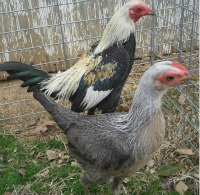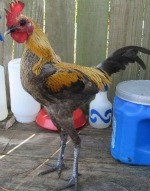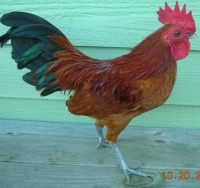Modern Game: The Tall Unique Bird
The modern game chicken breed is a tall bird with a very distinctive appearance and comes in many varieties.
Modern Game Facts:
Class: Standard: All Other Standard Breeds
Size: Standard Male: 6 Ibs. Standard Female: 4.5 Ibs. Bantam Male: 22 oz. Bantam Female: 20 oz.
Comb, Wattles & Earlobes: They have a small single comb with five points that stand upright. They have small, thin, smooth wattles and earlobes. All are bright red, unless otherwise noted. The comb, wattle, and earlobes are dubbed in cocks when they are used for show.
Color:
Barred: The beak is horn and the eyes are red. The shanks and toes are yellow and they have standard barred plumage.
Birchen: The comb, wattles, and earlobes are mulberry and the beak, eyes, shanks, and toes are all black. They have standard birchen plumage.

Black: The beak is black and the eyes are dark brown. The shanks and toes are black and they have standard
black plumage.
Black-Breasted Red: The beak is dark brown and the eyes are red. The shanks and toes are willow and they have standard black-breasted red plumage.
Blue: The comb, wattles, and earlobes are mulberry and the beak, eyes, shanks, and toes are black to leaden black. They have standard blue plumage.
Blue-Breasted Red: The beak is horn and the eyes are red. The shanks and toes are willow. Male: The head is light orange and the hackle and saddle are golden red. The back is rich red and the front of the neck, breast, body, legs and tail are blue. The wings are blue with red and bay highlights. Female: The head is orangy red and the hackle is light orange with a blue stripe down the middle of each feather. The front of the neck and breast are light salmon shading to ashy gray as it bends with body feathers. The body, wings, legs, and tail are bluish gray stippled with brown, which gives the overall effect of a dreary brown.

Brown Red: The comb, wattles, and earlobes are mulberry and the beak, eyes, shanks, and toes are all black. They have standard brown-red plumage.
Crele: The beak is horn and the eyes are red. The shanks and toes are yellow. Male: They have barred orange red against a pale yellow straw like color on the head, hackle, back, and saddle. The remainder is barred gray and white. Female: The head and hackle are pale gold barred with grayish brown. The front of the neck and breast are salmon that shades to and ashy gray as it blends with the body. The remainder is dark to ashy gray with some barring.
Cuckoo: The beak is horn and the eyes are red. The shanks and toes are yellow and they have standard cuckoo plumage.
Ginger Red: The beak is horn and the eyes are red. The shanks and toes are willow and they have standard ginger red plumage.
Golden Duckwing: The beak is horn and the eyes are red. The shanks and toes are willow and they have standard golden duckwing plumage.
Lemon Blue: The comb, wattles, and earlobes are mulberry and the shanks and toes are all black. They have standard lemon blue plumage.
Red Pyle: The beak is yellow and the eyes are red. The shanks and toes are yellow and they have standard red
pyle plumage.
Self Blue: The beak is black and the eyes are dark brown. The shanks and toes are black and they have standard self blue plumage.
Silver Blue: The comb, wattles, and earlobes are mulberry and the beak, eyes, shanks, and toes are all black. The head is silvery white and the hackle is lustrous blue laced with silvery white. The front of the neck and breast are slaty blue laced with silvery white. Male: The back is a lustrous silvery white and the saddle and upper breast are blue laced with silvery white. The lower breast, body, and legs are dark slaty blue. The wing coverts are dark blue, forming a distinct bar across the wing. The shoulders and fronts are dark blue laced with darker blue. The tail is dark blue.
Silver Duckwing: The beak is horn and the eyes are red. The shanks and toes are willow and they have standard silver duckwing plumage.
Wheaten: The beak is horn and the eyes are red. The shanks and toes are yellow to light willow and they have standard wheaten plumage.
White: The beak is yellow and the eyes are red. The shanks and toes are yellow and they have standard white plumage.
Place of Origin: England
Conservation Status: Study
Special Qualities: They are a tall bird with very distinct characteristics. They will rarely be confused with another bird.

The Modern Game was originated in England by breeding Old English Games and Malays. The breeders were in search of a good show bird as cockfighting was made illegal in 1849.
At about this time, the show bird circuit was exploding in popularity. These show people wanted a unique looking bird for exhibition and this is where the modern game stemmed from.
The bird has a long thin neck and a very upright posture. The breed is slow to mature and not very winter hardy. The breed commonly needs insulated or heated housing in places that are subject to extreme winter temperatures.
The Modern Game breed is active and noisy and generally do not tolerate close confinement. They can be aggressive, but most keepers say they are generally personable and curious birds that are enjoyable to be around.
The hens are good mothers and will go broody. They lay a fair amount of eggs for a bird with a game ancestry.
The Modern Game was first admitted to the APA in 1874.

Custom Search



New! Comments
Have your say about what you just read! Leave me a comment in the box below.